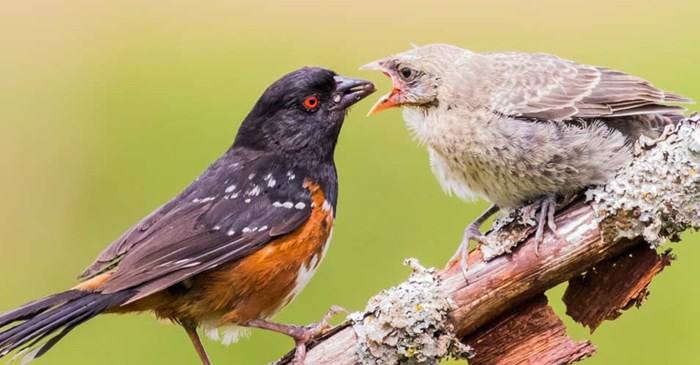As baby birds make their wobbly exit from the crowded nest, they enter the final stretch into adulthood known as the juvenile stage.
Arguably, we humans may not give this phase the same level of appreciation that we do for eggs and the helpless. But in the late spring, keep your eyes and ears open because there’s plenty of activity transpiring right in your backyard.
When it’s time for birds to leave the nest, they can be anywhere from 12 to 21 days old, depending on the species. When they emerge from their nests, their bone structure is just about the same size as their parents, but these birds are still developing.
- Their tail feathers may not be full length yet (because otherwise that would have made the nest really crowded).
- Their wings are shorter, which makes for frequent crash landings.
- Their beaks are shorter and stubbier. If the adult beak is yellow or orange, the juvenile beak may still be brown in color.
The most notable difference, though, between the juveniles and their adult counterparts is in their coloring and texture. You may still see some fluffy downy feathers poking out, giving them a slightly ruffled, disheveled appearance. Juveniles of colorful species will appear plainer than their parents with streaky or spotted markings to help them camouflage against predators. This camouflage is very important because, since they can’t fly off for a speedy getaway, the juvenile birds will be spending a lot of their time scooting on the ground or perching in bushes and shrubs.
Once the juveniles leave the nest, it’s no longer their home. But that doesn’t mean they’re forgotten by their parents. Mom and Dad are still nearby, keeping watch. Though the young are scattered, they’re always chirping, so parents can easily find them. When the parent appears with a tasty insect or worm in its beak, the juvenile will wave its wings, open its beak, and plead for the food.
Over the next month or so, the juveniles will learn to find their way in the world. You may see a baby robin pecking at the ground, as a parent points out the visible end of a worm. Or you may notice a family of chickadees in the tree overhead, hopping from twig to twig, chirping and chattering softly. You might even see a House Finch at your feeder, feeding a pair of young birds.
During this time of growth, the juvenile’s wings will become longer and stronger, allowing it to have longer, more graceful flights, and fewer crash landings. Eventually, its mottled, ruffled appearance will give way to a new set of sleek, shiny colorful feathers. And, one day, the juvenile bird’s pleas for food will be met with tough love from parents.
Throughout the spring, keep your feeders filled with the Lyric Fine Tunes No Waste Mix. You’ll give nesting songbirds a helping hand with easy access to food and energy.
